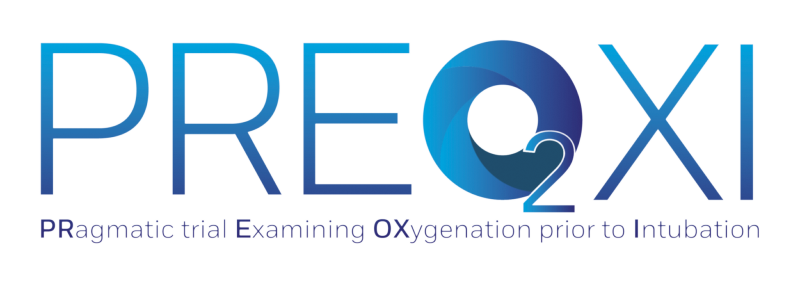
When patients need a breathing machine, a breathing tube is placed through the mouth and into the windpipe. During placement of the breathing tube, patients may experience serious problems with low oxygen levels. Doctors give oxygen through a mask before the procedure to prevent low oxygen levels. Two types of oxygen mask are commonly used, non-invasive ventilation and facemask oxygen. Both provide oxygen. Non-invasive ventilation also provides positive pressure to open the lungs and provide breaths when a patient’s breathing slows or stops. Both types of masks are FDA approved and both are frequently used in emergency department (ED) and intensive care unit (ICU). The PREOXI study focused on determining if one type of mask is better than the other.
Importance
Among critically ill adults undergoing tracheal intubation, hypoxemia increases the risk of cardiac arrest and death. Before the PREOXI Trial, the effect of preoxygenation with noninvasive ventilation, as compared with preoxygenation with an oxygen mask, on the incidence of hypoxemia during tracheal intubation was uncertain.
Objective
To determine the effect of preoxygenation with noninvasive ventilation, as compared with preoxygenation with an oxygen mask, on the incidence of hypoxemia during tracheal intubation among critically ill adults. Design, setting, and participants: the PRagmatic trial Examining OXygenation prior to Intubation (PREOXI) was a multi-center, parallel-group, non-blinded, randomized clinical trial among 1,301 patients undergoing tracheal intubation in 24 emergency departments and intensive care units across the United States.
Interventions
Patients were randomly assigned to receive preoxygenation with either noninvasive ventilation (n=645) or an oxygen mask (n=656). Main outcomes and measures: the primary outcome was hypoxemia during intubation, defined by an oxygen saturation of less than 85% during the interval between induction of anesthesia and 2 minutes after tracheal intubation. The secondary outcome was the lowest oxygen saturation during the interval between induction of anesthesia and 2 minutes after tracheal intubation.
Results
Among the 1,301 patients enrolled, hypoxemia occurred in 57 patients (9.1%) in the noninvasive ventilation group and in 118 (18.5%) in the oxygen- mask group (difference, -9.4 percentage points; 95% confidence interval [CI], – 13.2 to -5.6; P<0.001). Cardiac arrest occurred in 1 patient (0.2%) in the noninvasive-ventilation group and in 7 patients (1.1%) in the oxygen-mask group (difference, -0.9 percentage points; 95% CI, -1.8 to -0.1_> Aspiration occurred in 6 patients (0.9%) in the noninvasive-ventilation group and in 9 patients (1.4%) in the oxygen-mask group (difference, -0.4 percentage points; 95% CI, -1.6 to 0.7).
Materials
| Ventilator Model | Manufacturer | NIV Capability | Required Software Version | |
|---|---|---|---|---|
| Puritan Bennett 980 | Medtronic | Yes | IE SyncTM Software Version 2.8 and Above | |
| Servo-I | Getinge Maquet | Yes | Base Software (v3.0 or higher) | |
| Servo-U | Getinge Maquet | Yes | Base Software (v2.0 or higher) | |
| Hamilton G5 | Hamilton Medical | Yes | Base Software (v2.0 or higher) | |
| Carescape R860 | General Electric (GE) | Yes | Base Software (v10 or higher) | |
| Infinity | C500 Dräger | Yes | SW 2.n | |
| Evita | XL Dräger | Yes | Software Version 4.n or higher, latest Version 6.0 | |
| Puritan Bennett 840 (PB840) | Medtronic | Yes | Software Version 7.3 or higher |
| Ventilator Model Puritan Bennett 980 |
|---|
| Manufacturer Medtronic |
| NIV Compatibilty Yes |
| Required Software IE SyncTM Software Version 2.8 and Above |
| Ventilator Model Servo-I |
|---|
| Manufacturer Getinge Maquet |
| NIV Compatibilty Yes |
| Required Software Base Software (v3.0 or higher) |
| Ventilator Model Servo-U |
|---|
| Manufacturer Getinge Maquet |
| NIV Compatibilty Yes |
| Required Software Base Software (v2.0 or higher) |
| Ventilator Model Hamilton G5 |
|---|
| Manufacturer Hamilton Medical |
| NIV Compatibilty Yes |
| Required Software Base Software (v2.0 or higher) |
| Ventilator Model Carescape R860 |
|---|
| Manufacturer General Electric (GE) |
| NIV Compatibilty Yes |
| Required Software Base Software (v10 or higher) |
| Ventilator Model Infinity |
|---|
| Manufacturer C500 Dräger |
| NIV Compatibilty Yes |
| Required Software Software Version 2.n |
| Ventilator Model Evita |
|---|
| Manufacturer XL Dräger |
| NIV Compatibilty Yes |
| Required Software Software Version 4.n or higher, latest Version 6.0 |
| Ventilator Model Puritan Bennett 840 (PB840) |
|---|
| Manufacturer Medtronic |
| NIV Compatibilty Yes |
| Required Software Software Version 7.3 or higher |
Conclusions and Relevance
Among critically ill adults undergoing tracheal intubation, preoxygenation with noninvasive ventilation resulted in a lower incidence of hypoxemia during intubation than preoxygenation with an oxygen mask.
ClinicalTrials.gov Identifier: NCT05267652
Manuscript Title: Noninvasive Ventilation for Preoxygenation during Emergency
Intubation
Journal: New England Journal of Medicine
PMID: 38869091
